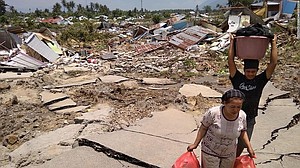10/3/2018

By Bard Wilkinson, CNN
(CNN) -- Rivers of soil swept away entire neighborhoods in Indonesia following a powerful earthquake last week that also generated a tsunami in a disaster that has killed at least 1,407 people.
Experts say the destruction is due to soil liquefaction, a process occurring when soil becomes saturated with water causing it to erupt into tumultuous torrents, as it did on Friday, shifting and tumbling buildings.
Footage has emerged from the stricken city of Palu showing people running to find solid ground as structures were swept away and destroyed by waves of undulating earth. Images show a section of the city being erased by surging soil.
In Petobo town the ground under the length of an entire main road was torn up, with the tide of soil leaving broken stretches of tarmac-topped debris in wave-shaped mounds and troughs.
"Liquefaction occurs when loose sandy soils with shallow groundwater are subjected to sudden loading such as shaking from an earthquake," said Jonathan Stewart, professor of Civil and Environmental Engineering Department at UCLA.
Many experts liken the process to waves lapping on a sandy beach. When the waves come in, the sand softens, but when the waves withdraw, the sand stiffens.
"During the earthquake, water pressure is generated in the soil, which causes a dramatic loss of strength," said Stewart. "The strength loss can be so great that the soil behaves almost like a liquid."
Soil running downhill, known as "flow failure," is one of the most severe effects of liquefaction, and prone to occur in areas with a particular soil structure.
"The soils in the slide area are likely geologically young, loose, sandy materials with shallow groundwater," said Stewart.
Was the earthquake triggered by a volcano?
Scientists say that the devastating sequence of natural disasters were the result of a highly unusual series of geological events, which may be related to the eruption on Wednesday of the Soputan volcano, also on Sulawesi island.
"Did the bulging magma chamber of the volcano trigger the earthquake? Or did the earthquake trigger the magma chamber to pass magma to the funnel of the volcano?" said Professor Costas Synolakis, director of the University of South California Tsunami Research Center.
According to Synokalis, volcanic eruptions are very often preceded by swarms of earthquakes, which are typically smaller than magnitude 5.
"It is all beginning to look like a Hollywood movie scenario," added Synokalis. "A (7.5 magnitude) earthquake with a mechanism not usually associated with tsunamis triggers a big one, and volcanic activity at a distance from the earthquake far larger than usually expected for causation."
The epicenter of Friday's earthquake was on land and not at sea, meaning the probability of a tsunami was low. Many experts have theorized that the tsunami was therefore triggered not by the earthquake itself but by a submarine landslide caused by the earthquake.
Geotechnical engineering
Though such a chain of events are rare and therefore difficult to mitigate, scientists say that engineering techniques do exist to lessen the impact of soil liquefaction.
"As with most problems, the first step in mitigation is recognizing that a problem exists," said Stewart. "We have engineering procedure for this. Had they been applied, there is a good chance the hazard would have been recognized."
Several techniques are used to stop flow slides. The easiest is the construction of a strengthened zone in the soil near the lower end of the slope, said Stewart.
Approaches to this in geotechnical engineering include densification of the soil by the injection of materials, or the compaction of sediments and soils using weights or vibration that mimic earthquake processes, said Adam Switzer, principal investigator at the Earth Observatory of Singapore.
Another method, he added, is the use of "earthquake drains'" that aim to mitigate liquefaction by releasing pressure before it reaches critical levels.
Synolakis said that other ways to treat liquefaction is to avoid building multi-story structures and regulate to require deep foundations.
But in poorer countries these techniques might be too costly for government and individual budgets.
"Many of the mitigation techniques are likely to be well beyond the means of the average homeowner in southeast Asia," Switzer told CNN.
In absolute terms careful choice of construction sites or relocation are the best defense against soil liquefaction, scientists said.
"The only way to completely mitigate the problem would be to... move developments off the liquefied soils," said Stewart.
The process is thought to have played a key role in previous disasters, such as the Japan earthquake in 2011, where the extent of the liquefaction over hundreds of miles was daunting to experienced engineers.
A study found that liquefaction wrought more devastation than shaking in the Christchurch, New Zealand, earthquake in 2011.
